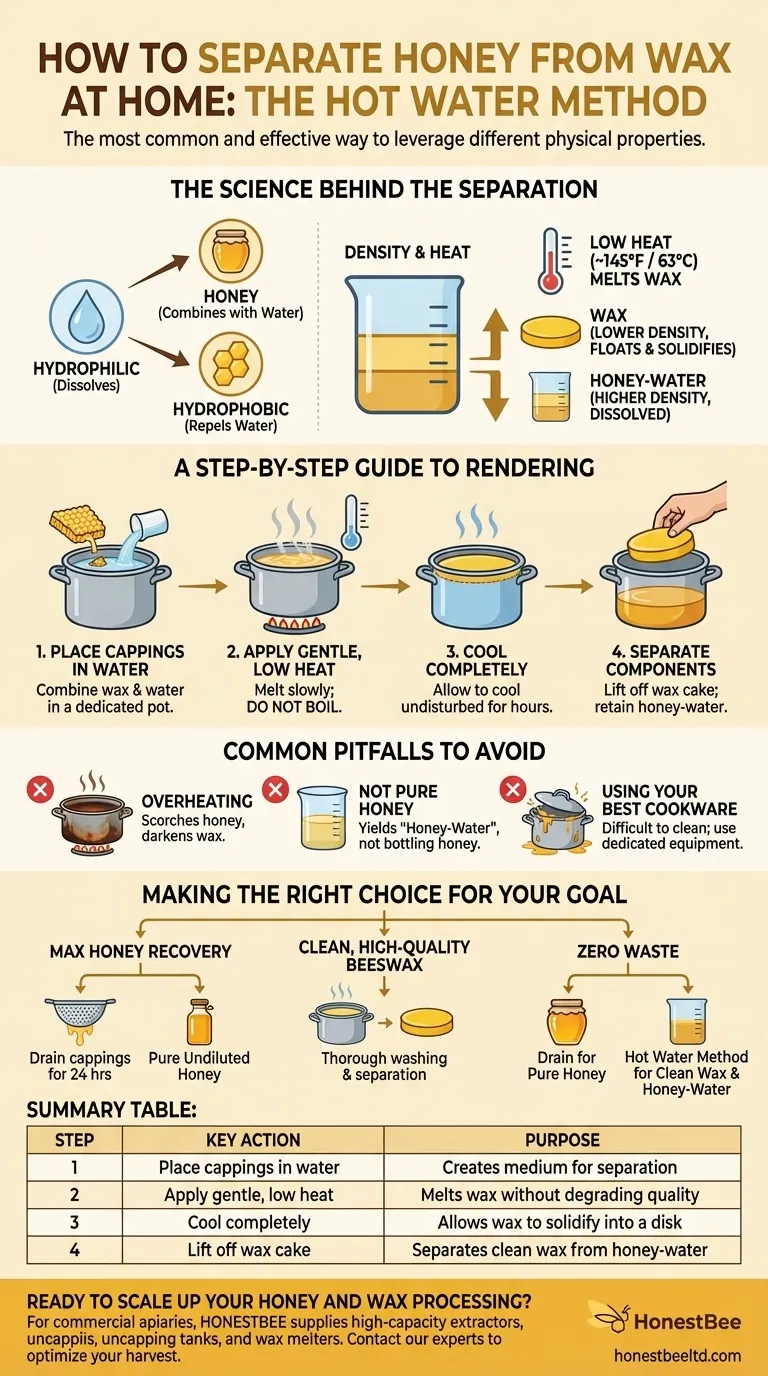The most common and effective way to separate honey from wax at home is by using hot water. You gently melt the honey-laden wax cappings in a pot of water; because wax is lighter than water, it will float to the top. As the mixture cools, the wax solidifies into a clean disk that can be easily lifted off, leaving the honey dissolved in the water below.
The core principle behind separating honey and wax is leveraging their different physical properties. Gentle heat melts the low-melting-point wax, while water acts as a medium to dissolve the honey and allow the buoyant, water-insoluble wax to float and separate.

The Science Behind the Separation
Why Water is the Key Ingredient
Water is the ideal medium for this process because honey is hydrophilic (it readily dissolves in water), while beeswax is hydrophobic (it repels water).
This fundamental difference means that when you introduce the mixture to water, the honey leaches out of the wax and combines with the water, leaving the wax behind.
The Role of Density and Heat
Beeswax has a lower density than water, causing it to float. Applying gentle, low heat is only necessary to melt the wax (around 145°F or 63°C), which allows it to release trapped honey and coalesce into a single layer on the surface.
A Step-by-Step Guide to Rendering
Step 1: Place Cappings in Water
Combine your wax cappings with water in a large pot you don't mind dedicating to wax work. A good ratio is roughly equal parts water and wax by volume, but precision is not critical.
Step 2: Apply Gentle, Low Heat
Heat the pot on a low setting. The goal is to melt the wax slowly, not to boil the water. Boiling can darken the wax and degrade the quality of any remaining honey. Stir occasionally until all the wax has liquified.
Step 3: Cool Completely
Once the wax is fully melted, turn off the heat and allow the pot to cool completely and undisturbed for several hours or overnight. As it cools, the wax will rise to the surface and solidify into a hard, clean cake.
Step 4: Separate the Components
After cooling, the solid disk of beeswax can be easily lifted off the top. The water underneath will now be a sweet "honey-water" mixture, and any heavy debris (sometimes called "slumgum") will have sunk to the bottom of the pot.
Common Pitfalls to Avoid
Overheating the Mixture
The most common mistake is applying too much heat. High temperatures can scorch the honey and darken the beeswax, reducing its quality and value for cosmetic or candle-making purposes. Always use low, gentle heat.
The Fate of the Honey
You must understand that this method does not yield pure, liquid honey. The honey dissolves into the water, creating a sweet liquid. This "honey-water" cannot be bottled as regular honey but is excellent for feeding back to your bees, baking, or as a base for making mead.
Using Your Best Cookware
Beeswax is notoriously difficult to clean from pots and utensils. It is highly recommended to use dedicated equipment for processing wax to avoid ruining your primary kitchenware.
Making the Right Choice for Your Goal
After uncapping your frames, you can decide which approach best fits your needs.
- If your primary focus is maximum honey recovery: Let your cappings drain in a strainer for 24 hours before doing anything else. This passive dripping will recover the most honey in its pure, undiluted state.
- If your primary focus is clean, high-quality beeswax: The hot water melting method is the most thorough way to wash the wax and separate it from residual honey and debris.
- If your primary focus is zero waste: Perform both steps. First, let the cappings drain to recover pure honey, then melt the drained cappings in water to produce clean wax and a usable honey-water byproduct.
By applying these simple principles, you can ensure no part of your valuable harvest goes to waste.
Summary Table:
| Step | Key Action | Purpose |
|---|---|---|
| 1 | Place cappings in water | Creates medium for separation |
| 2 | Apply gentle, low heat | Melts wax without degrading quality |
| 3 | Cool completely | Allows wax to solidify into a disk |
| 4 | Lift off wax cake | Separates clean wax from honey-water |
Ready to scale up your honey and wax processing? For commercial apiaries and distributors, efficient equipment is key to maximizing yield and profitability. HONESTBEE supplies durable, high-capacity honey extractors, uncapping tanks, and wax melters designed for professional use. Let us help you optimize your harvest. Contact our wholesale experts today to discuss your beekeeping supply needs!
Visual Guide

Related Products
- 8-Frame Electric Self-Reversing Honey Extractor Spinner for Commercial Honey Extraction Equipment
- Electric Beeswax Flat Sheet Machine with Operating Tray for Wax Processing
- Professional Thermostatic Conical Honey Melter
- Extra Wide Stainless Steel Honey Uncapping Fork with Scraper Beekeeping Tool
- High Quality Honey Dehumidifier Dryer Thickening Machine for Beekeeping
People Also Ask
- What are the benefits of using a honey extractor? Maximize Harvest & Save Bee Energy
- What factors should be considered when choosing the size of a honey extractor? Maximize Your Harvest Efficiency
- What is a honey extractor and how does it benefit beekeepers? Boost Honey Yield & Hive Health
- How do automatic honey extractors function? Achieve High-Efficiency Honey Harvesting
- What should a beekeeper do after extracting honey from supers? A Guide to Harvest Management



















